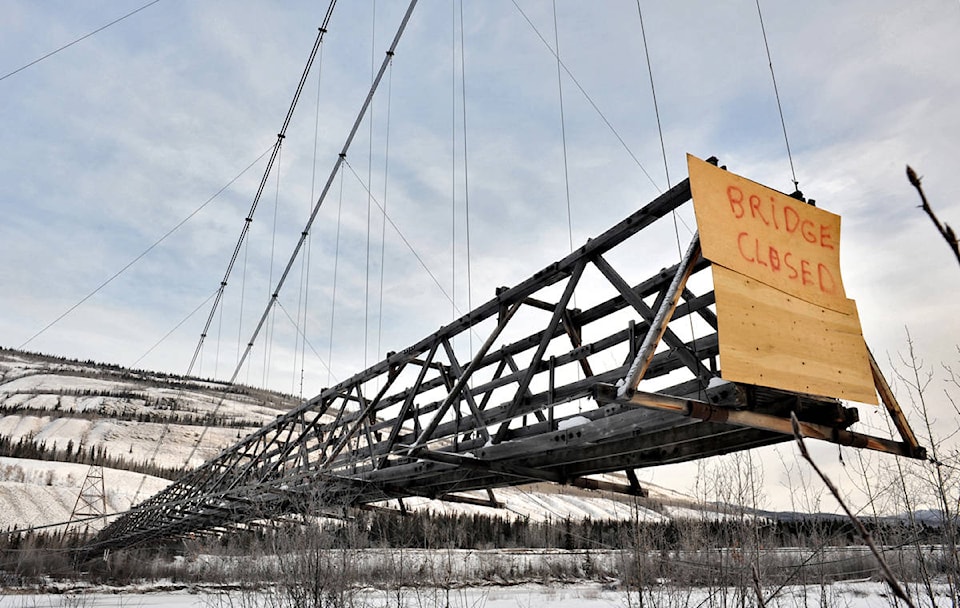The bill for the next phase of repairs to the Ross River footbridge could come in $1 million over budget.
Bidding for the work, slated to start this summer, closed July 5. Government documents show the lowest bid was just under $4 million.
That’s substantially more than the $3 million budget the territorial government had set for this last phase of work.
Four companies bid on the project, all from Outside. The bids go as high as $5.8 million.
The lowest bid was submitted by Surespan Construction Ltd. out of North Vancouver.
So far the Department of Community Services won’t say what the high bids mean for the future of the bridge.
No one directly connected to the project was made available to talk about what happened. In a written statement, spokesperson Diana Dryburgh said the department “will hold an internal funding review to determine our next steps. As soon as we have more information about the future of this project, we will share it.”
Community Services Minister John Streicker said it was too early to say whether the government is willing to spend an extra million dollars on the project.
“When the bids come in high then we need to take this to cabinet for a full conversation — it is a requirement — and also would want to take it to the community and make sure it’s still what they want.”
The minister said he hasn’t had a chance to speak with community members or representatives from the First Nation.
Just because the plans are being re-evaluated doesn’t mean the bridge is not a priority, Streicker said.
“It just means there’s so many different outcomes that could happen here I don’t want to give a sense of where it’s landing.”
Work on the Ross River footbridge started in 2013. That’s when it was discovered that the old structure was so unsafe the bridge needed to come down.
The community protested and the Yukon Party government of the time agreed to save the structure.
Since then $1.6 million in federal and territorial money was spent to stabilize the north and south towers.
The government so far hasn’t said how much it cost the Yukon to cancel the original plan to knock the bridge down.
Even after the first round of repairs, the bridge still couldn’t be walked on. In order for it to be useable again, this year’s final repairs included new stairs, cables, anchors and decking.
The majority of the $3 million came from the federal government. Ottawa agreed to chip in up to $2.25 million and Yukon agreed to contribute the remaining $750,000.
It’s not clear whether Yukon could ask the federal government to up the amount of money it’s willing to spend on the bridge.
“These are issues that will be considered during the internal review process,” Dryburgh said in her email.
Dryburgh said the Yukon government has seven more years to use the money that came from the Small Communities Fund. “Canada has approved the funding for this project and a delay in the schedule will not affect the project’s status.”
Yukon Party MLA Stacey Hassard believes the government needs to spend the extra cash on the bridge.
“The bridge is vital to the community and it needs to be there,” he said.
Hassard, the MLA for Pelly-Nisutlin and the interim leader of the Yukon Party, questioned why the government’s estimate was not in line with what companies bid.
“The Liberal government made such a big deal out their new budgeting process. They said that it’s going to account for the true cost,” he said.
“In fact it was the reason we went back into the legislature so late this spring because they needed to do all this work to ensure that the budgeting was done properly.”
For its part, the department will only say that government estimates “are typically developed by our engineering consultants.”
“We cannot speculate at this time the difference between the estimate and the bid prices,” Dryburgh said.
This year’s territorial budget includes a small surplus of only $6.5 million. That means the government has very little wiggle room for surprises before it would run a deficit.
The Ross River footbridge was constructed by the U.S. Army in 1944 to carry an oil pipeline over the river. It was later retrofitted as a footbridge.
It is the only thing that connects the two sides of the Pelly River during freeze-up and break-up when the local ferry can’t run.
Back in January Streicker said the hope was that the bridge would be completely repaired this summer. Now that deadline seems more up in the air.
“I don’t know what is reasonable now because it’s going to depend on several things,” he said.
Streicker said discussions about the bridge will be part of the next cabinet meeting.
Contact Ashley Joannou at ashleyj@yukon-news.com
